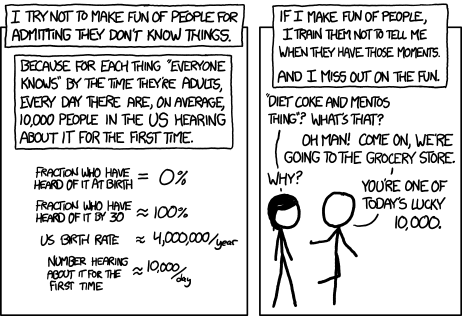Make math mistakes in public!

Looking at many polished photos of other people’s gorgeous vacations leads to depression, as Jessica Winter summarizes in Selfie-Loathing. What happens when students keep looking at perfectly solved problems, smooth proofs of theorems, and flawless geometric constructions? They get math anxiety!
In his public service announcement, “Don’t learn the solutions before class!” and in the comments, Gordon Hamilton explains how teachers’ mistakes help students.
Teachers should be the same species as their students. Too often we have teachers who want to know all of the solutions of problems before the class begins. This is setting them up to be birds teaching bats. The students are flying blind. Learning the solutions puts you in a less favorable space to teach your students. Set up a classroom where the stigma of failure has been removed. The best way to do that is to start with yourself.

Posamentier and Lehmann make another point in their new book: mistakes can lead to new insights and discoveries. It works for professional mathematicians and for young kids making their first steps in math. Here is a part of the introduction:
We can also consider how the “proof” that 1 = 0 leads us to a most important mathematical concept: that division by zero is not permissible. Follow along as we show this interesting little “proof.” We begin with our given information that x = 0. We then multiply both sides of this equation by x – 1 to get x(x – 1) = 0. Now dividing both sides by x leaves us with x – 1 = 0, which in turn tells us that x = 1. However, we began with x = 0. Therefore, 1 must equal 0. Absurd! Our procedure was correct. So why did we end up with an absurd result? Yes, we divided by zero when we divided both sides of the equation by x. Division by zero is not permitted in mathematics, as it will lead us to silly conclusions. This is just one of many such entertaining mistakes that give us a more genuine understanding of the rules of mathematics.
These examples may seem entertaining, and they are. Yet through these entertaining illustrations of mistakes a lot is to be learned about mathematical rules and concepts. For example, when we “prove” that every triangle is isosceles, we are violating a concept not even known to Euclid – that of betweenness. When we show that the sum of the lengths of two legs of a right triangle is equal to the length of the hypotenuse – clearly violating the time-honored Pythagorean theorem – we will be showing a misuse of the concept of infinity. Yet, it is the unique value of these mistakes – providing a better understanding of the basic concepts of mathematics – that makes these mistakes magnificent. Lest we forget, youngsters – and we dare say, adults as well – learn quite a bit from mistakes. We expect that through the playful style in which we present these mistakes the reader will be delightfully informed! We shall also compare mathematical mistakes with those in everyday life and notice what can be learned from these.
We expect that the readers will enjoy these examples, and during this delightful excursion they should appreciate the many aspects or nuances of mathematics that sometimes go unnoticed until they lead one astray. We invite you now to begin your journey through these many magnificent mistakes in mathematics.
Do show your students imperfect, human, live math! Celebrate their mistakes by exploring the possibilities together. You can also rejoice in what students don’t know, as XKCD illustrates. Learning is exciting. But before you learn, you need to – not know!

Captain Sheridan of Babylon V (a sci-fi series) gives his signature good-luck speech whenever he assumes command. The speech has some of the most important lessons he learned in his life:
When I was 21, I visited Tibet. I went to see the new Dalai Lama. Uh, you do that sort of thing when you’re 21 and the son of a diplomatic envoy. We had a simple dinner. Rice, raisins, carrots—steamed, not boiled—and green tea. When it was over, he looked at me and said, “Do you understand?” I said no, I didn’t. “Good beginning,” he said. “You’ll be even better when you begin to understand what you do not understand.”
One of my favorite math exercises is to invite students to make as many mistakes in a problem as they possibly can. Can you make ridiculous mistakes? Funny mistakes? Big huge mistakes? Subtle mistakes that are hard to notice? This exercise and the math discussions it starts is worth a stack of worksheets for how much math students learn. Making mistakes on purpose also helps students laugh, relax, and carry on their challenging math journeys.
Related Posts
Posted in Grow







Leave a Reply